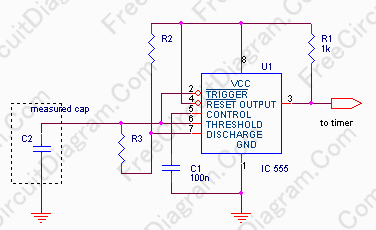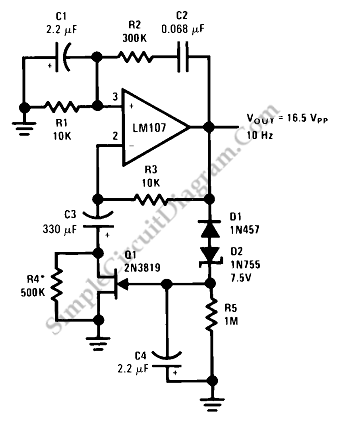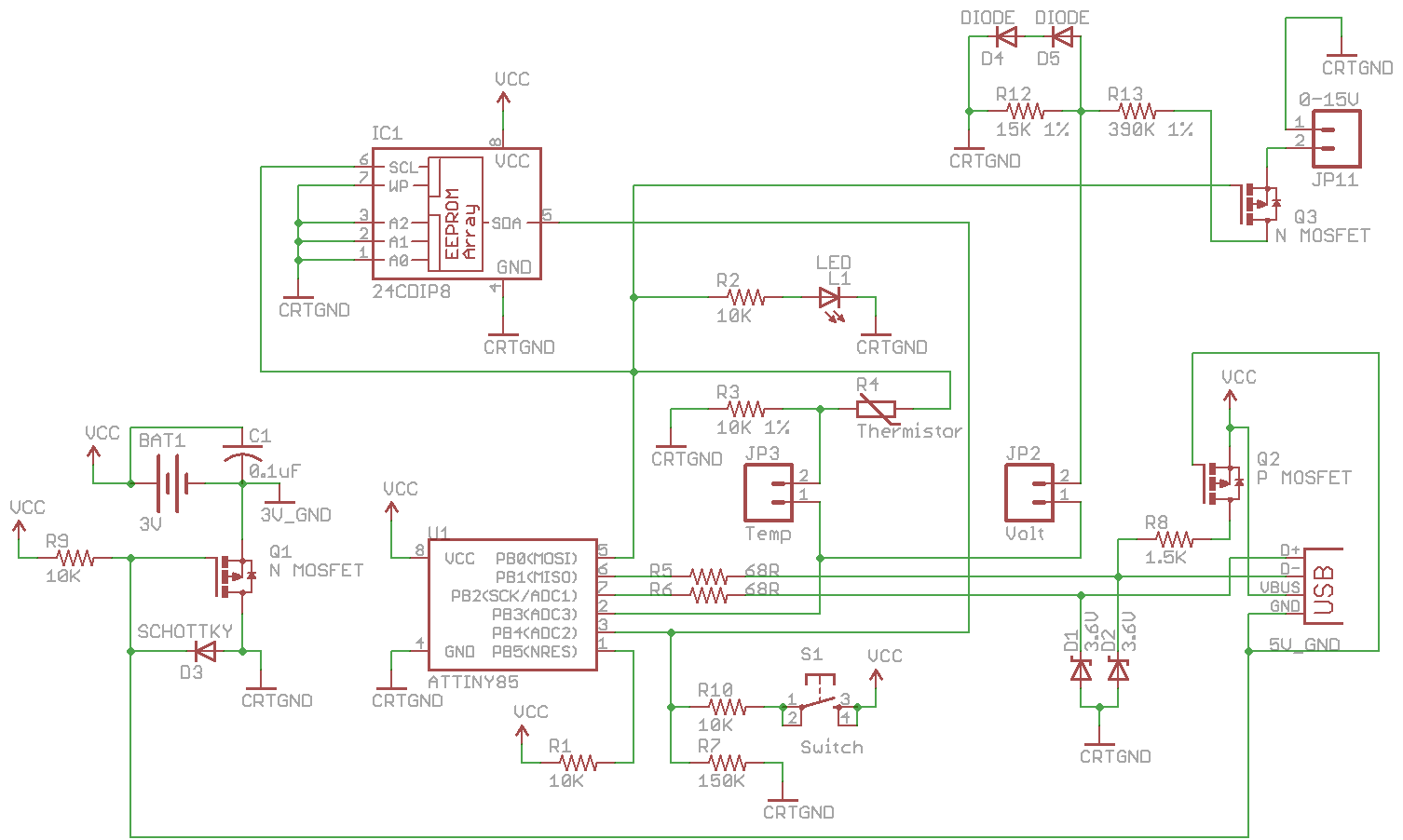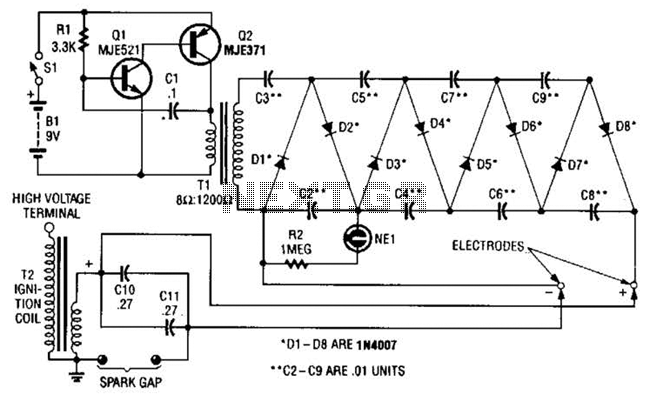
10 Hz to 10 Khz Voltage Controlled Oscillator
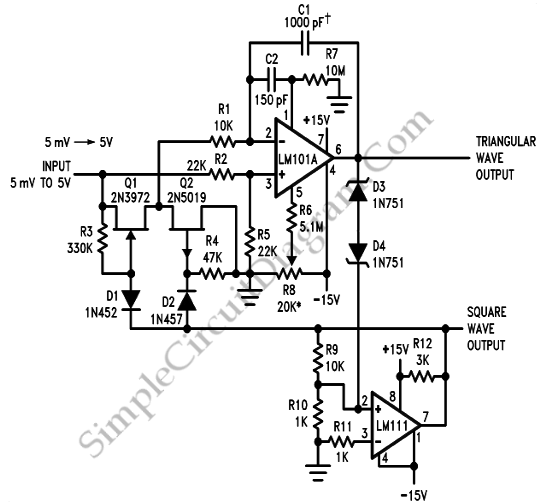
A voltage-controlled oscillator (VCO) is an oscillator whose frequency is regulated by a voltage signal. The VCO discussed here can generate both triangular and square wave outputs. The control voltage can be adjusted between 5 mV and 5 V, resulting in an oscillation frequency range of 10 Hz to 10 kHz. The schematic diagram represents a micropower voltage-controlled oscillator circuit that can produce square and triangle wave outputs while drawing only 50 µA from a single 5 V power supply. This circuit comprises a combination of an inexpensive quad CMOS.
The voltage-controlled oscillator (VCO) is a critical component in various electronic systems, serving as a signal generator with variable frequency outputs that are dependent on the control voltage applied at its input. In the described VCO circuit, the design allows for the generation of both triangular and square waveforms, providing versatility for different applications.
The operational range of the control voltage, spanning from 5 mV to 5 V, enables the user to modulate the output frequency from 10 Hz to 10 kHz. This range is particularly useful in applications such as signal modulation, tone generation, and frequency synthesis, where precise frequency control is necessary.
The schematic diagram illustrates a micropower VCO circuit that is designed to operate efficiently with minimal power consumption. With a current draw of only 50 µA from a single 5 V supply, this circuit is suitable for battery-operated devices and low-power applications. The use of a quad CMOS configuration allows for the integration of multiple functions within a single package, reducing component count and overall circuit complexity.
The triangular wave output can be utilized for applications requiring linear ramp signals, while the square wave output is ideal for digital signal processing and timing applications. The ability to produce both waveforms from a single VCO circuit enhances its utility in various electronic designs.
To implement this VCO circuit, careful consideration should be given to the selection of components, including the operational amplifiers and resistors used in the ramp generator configuration. The performance of the VCO can also be influenced by external factors such as temperature and power supply stability, which should be accounted for in the design process to ensure reliable operation across the specified frequency range.Voltage-controlled oscillator (VCO) is an oscillator that its frequency is controlled using a voltage signal. The VCO described here provide both triangular and square wave output. The control voltage can be varied between 5 mV to 5 V, to produce oscillation frequency from 10 Hz to 10 KHz.
Here is the schematic diagram of the circuit: This is a sc hematic diagram of a micropower voltage-controlled oscillator circuit. This circuit can generate square and triangle wave outputs and only need 50 µA from a single 5 V supply. This circuit consist of combination of an inexpensive quad CMOS Continue reading †’. VCO (voltage controlled oscillator) is an electronic signal generator which produce a signal that has variable frequency depends on a voltage level at its control input.
Many VCO circuits are based on ramp generator to produce a variable frequency output, Continue reading †’. 🔗 External reference
The voltage-controlled oscillator (VCO) is a critical component in various electronic systems, serving as a signal generator with variable frequency outputs that are dependent on the control voltage applied at its input. In the described VCO circuit, the design allows for the generation of both triangular and square waveforms, providing versatility for different applications.
The operational range of the control voltage, spanning from 5 mV to 5 V, enables the user to modulate the output frequency from 10 Hz to 10 kHz. This range is particularly useful in applications such as signal modulation, tone generation, and frequency synthesis, where precise frequency control is necessary.
The schematic diagram illustrates a micropower VCO circuit that is designed to operate efficiently with minimal power consumption. With a current draw of only 50 µA from a single 5 V supply, this circuit is suitable for battery-operated devices and low-power applications. The use of a quad CMOS configuration allows for the integration of multiple functions within a single package, reducing component count and overall circuit complexity.
The triangular wave output can be utilized for applications requiring linear ramp signals, while the square wave output is ideal for digital signal processing and timing applications. The ability to produce both waveforms from a single VCO circuit enhances its utility in various electronic designs.
To implement this VCO circuit, careful consideration should be given to the selection of components, including the operational amplifiers and resistors used in the ramp generator configuration. The performance of the VCO can also be influenced by external factors such as temperature and power supply stability, which should be accounted for in the design process to ensure reliable operation across the specified frequency range.Voltage-controlled oscillator (VCO) is an oscillator that its frequency is controlled using a voltage signal. The VCO described here provide both triangular and square wave output. The control voltage can be varied between 5 mV to 5 V, to produce oscillation frequency from 10 Hz to 10 KHz.
Here is the schematic diagram of the circuit: This is a sc hematic diagram of a micropower voltage-controlled oscillator circuit. This circuit can generate square and triangle wave outputs and only need 50 µA from a single 5 V supply. This circuit consist of combination of an inexpensive quad CMOS Continue reading †’. VCO (voltage controlled oscillator) is an electronic signal generator which produce a signal that has variable frequency depends on a voltage level at its control input.
Many VCO circuits are based on ramp generator to produce a variable frequency output, Continue reading †’. 🔗 External reference

